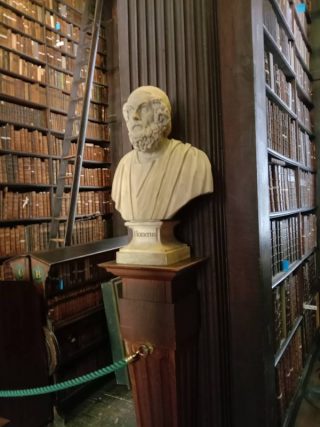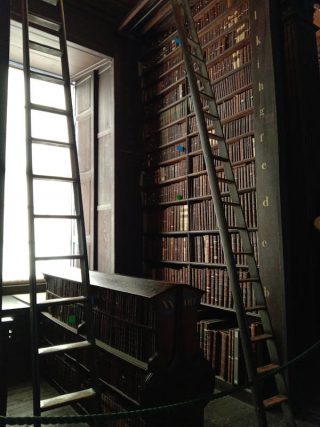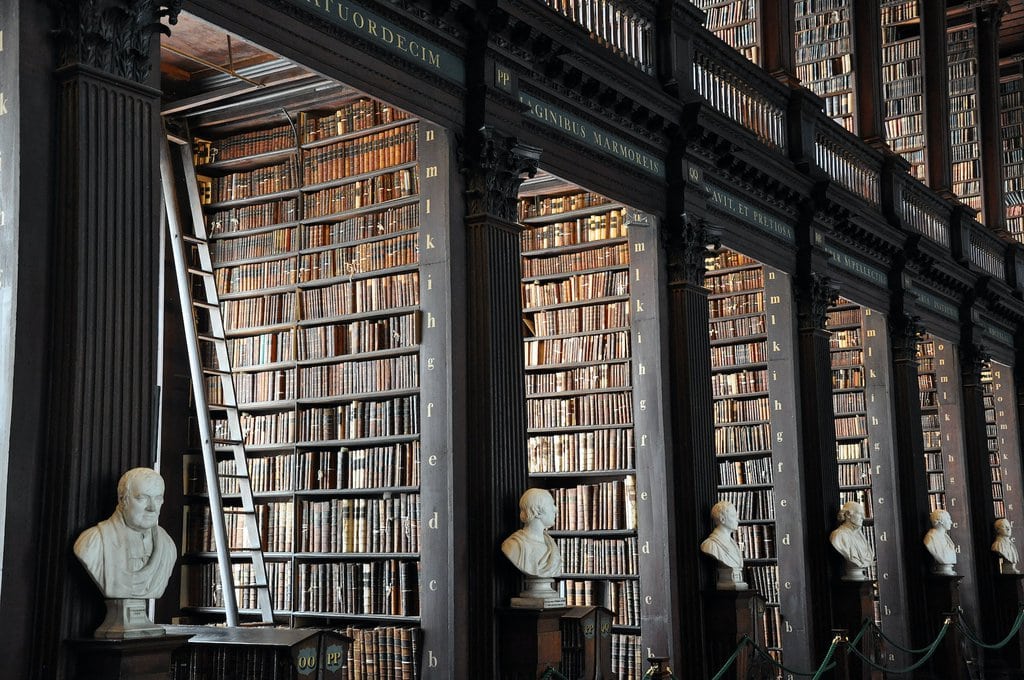A spotlight falls on these words on an inky black wall:
I have always imagined that paradise will be a kind of library – Jorge Luis Borges
Trinity College Library
It is February 2023 and I am waiting to walk into the Long Room of the library of Trinity College in Dublin, Ireland. This quote also sounds quite like paradise to me and only makes me even more eager to finally see the famous room with my own eyes.
The experience does not disappoint – it is a beautiful “book cathedral”! It is about 65 meters long and usually houses 200,000 of the library’s oldest books. The library was built between 1712 and 1732. In 1860 it was enlarged by raising the roof. Busts of great philosophers and writers of the Western world, as well as people with special ties to the library, are displayed on either side of the central corridor. Two other important objects on display are an original version of the 1916 Proclamation of the Irish Republic and a medieval harp which is the model for Ireland’s national emblem.
An extensive restoration project is currently underway. The building’s climate control and fire protection measures are being renovated and because dust and pollution take their toll, the 200,000 books are cleaned one by one with a special vacuum cleaner. It is then also electronically marked and catalogued.
The library is best known for housing the Book of Kells. This manuscript, which dates from the ninth century, mainly consists of the four Gospels of the New Testament. Regardless of its age, it is considered the finest extant illuminated manuscript from medieval Europe. Along with it, an exhibition can be seen that places the manuscript in historical perspective and includes related manuscripts.
Library tourism and the utility of print book collections
Under normal circumstances, more than one million people visit the library annually. Other famous libraries, for example the Bodleian of the University of Oxford in England, are just as crowded. A library can therefore be a major tourist attraction, which brings one to the question of whether printed books and libraries still retain their original purpose, or whether they have actually become specialized museums.
Printed books are feeling the pressure (pardon the pun) of reading material becoming increasingly available in other media. Often they are exhibited as decorative items, and there are even people who make a living out of creating entire libraries for individuals and companies to complement their decor and image as intellectual giants.

So do libraries have another use?
The answer is very definitely “yes”. It still remains free access to “real” books for people who are needy or thrifty.
Research is increasingly proving the need to be exposed to printed books from an early age. Some of the benefits include that it helps children develop sensory, for example, their tassin when they hold pages and turn the pages, sight when reading the text and looking at pictures, and even the sense of smell because books, as book lovers know, often smell very nice.
Furthermore, it was found that unlike screen reading material, books promote concentration because they require a slower reading process. This means that readers remember the content longer and predominantly develop a larger vocabulary than people their age who only read on screens. It is even proven that the contact between the feeling of a page between fingers and the brain creates a context that makes it easier for the reader to understand what he is reading and develop more empathy with the characters being read about. Moreover, too much screen reading often leads to health problems such as dry eyes and headaches.
Copyright challenges and printing costs make new books expensive items, so libraries will continue to be needed to give people access to them.
Libraries also stay current by also creating opportunities for screen reading. Other services are being added, such as toy libraries to attract young readers, or for older people the chance to take out puzzles, games and audio books.
A library as a source in itself
These buildings not only house sources, but sometimes they can also become a source themselves. One of the interesting examples in this connection brings us back to Trinity College Library.
The 200,000 books in the Long Room include the Fagel collection. It consists of around 20,000 books that date from 1478 to 1799 and belonged to the Dutch Fagel family as a working library over five generations. Some of them held high offices in the Dutch Republic in the seventeenth and eighteenth centuries. Unlike other collections of the time, it was not later dismantled piece by piece, but purchased as a whole in 1802 for Trinity College. It is one of the most important and largest Dutch private libraries from the eighteenth century that has been preserved in good condition.

By studying the collection, academics can learn more about the Fagels’ interests, seventeenth and eighteenth century printing, architecture of the time (the collection includes many sketches, pamphlets and even maps), political connections, trade, philosophy and many more. Videos about collaboration between Ireland and the Netherlands to unlock the collection more fully, tell how the sources not only with their content, but also their physical condition, inscriptions and composition offer us a key to life more than 200 years ago.
Who knows if a library or book collection of one of us might give people a glimpse of the world of 2024 in 200 years?
How can we support libraries?
Unfortunately, South African libraries struggle to get funding. Some of them have friend organizations that help raise money for supplementary purchases. These volunteers need all of our support.
Instead of just giving away or throwing away well-kept books and magazines, find out if a local town, city or school library might be able to use them.
In this way, we can help build a knowledgeable, emotionally healthy and literate community that appreciates historical book collections, but also has access to printed reading material that they can use for everyone’s benefit.








